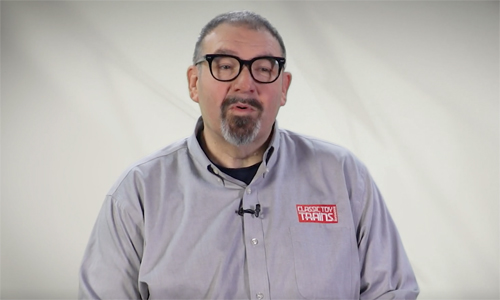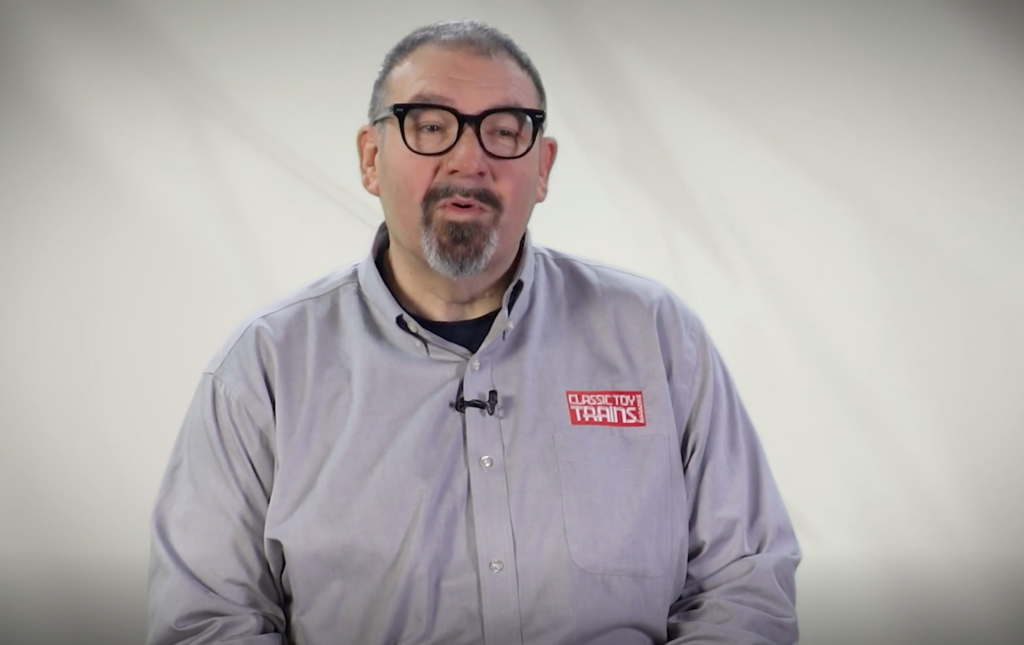See this interview with Hal Miller, Editor of Classic Toy Trains magazine. Trains.com Unlimited Members can see the video in the Trains.com Video section.
Steve Sweeney: So, ladies and gentlemen, welcome to another Q&A with the Editors. I’m so pleased to have Classic Toy Trains Editor Hal Miller. How are you today?
Hal Miller: I’m great. Fantastic, in fact.
SS: Glad to hear it. Hal, you’ve been with the company a few years, so if you don’t mind, would you just introduce yourself a little bit and give us some background?
HM: I came to Kalmbach Media Company back when it was Kalmbach Publishing Company as the managing editor of Trains magazine. And since then, I have been with every tracks related title in one capacity or the other as well as a magazine called Model Retailer, that went to the hobby stores and was a trade magazine. So, I’ve done a little bit or a lot of everything around Kalmbach over the years. In fact, I wrote recipes for magazine called Cabin Life at one point.
So yeah, they’ve kept me around just because I can do things here and there and a lot of different things like, you know, a utility player.
SS: So I’ve got five questions that I ask everyone who comes on here. And if you don’t mind, I’d like to start with those and we can carry on the conversation from there.
HM: Let’s go.
SS: So, first question. What is your favorite railroad, present or past, and why?
HM: My favorite railroad, that’s an easy one to pick out is Rock Island. And the Rock Island was really cool, not only in steam, but it was even more cool in diesel. Imagine a railroad that never said no to any locomotive manufacturer. Certainly in the diesel era. They had models from every major manufacturer and some minor manufacturers. They had a multitude of colorful paint schemes. And sometimes you got to see all of them or two or three, at least on the same train.
So it went to the big cities and went to Chicago, went to Dallas. It went a lot of places, but it also went to a lot of small places. And I find that really fascinating that it served so many things.
It was a redundant railroad in a lot of ways to some bigger ones, but it had more character than a lot of others. So that’s why I like it.
SS: All right. So the second question is, what is the best part about what you do?
HM: The best part about what I do is also maybe the worst part, and that is going to shows and meeting people. And the best part of that is actually meeting the people. The worst part of it is sometimes going to the shows and shows are a lot of work. I enjoy them, but they’re more work than being in the office. I’ve had to convince my wife of that on a number of occasions over the years. And then I took her to a show one time and she’s like, “You really do work at these, don’t you?” And I said, “Yeah, it’s not a vacation.” but the best part of that is getting out and talking to the people.
You’re making magazines and videos and content on Trains.com for and seeing how they like the content, seeing what they don’t like. You know complaints are just as valuable to me as praise. In fact, maybe more so. That helps us develop a better product for our customers. And, and I love just meeting people. That’s really who we’re in business for: the audience and the people who read us all the time.
SS: Very nice. Tell us about something exciting you’ve been working on lately.
HM: The one thing that you know is sort of a tangible project we’ve been working on lately. We built a Polar Express layout … for Classic Toy Trains. And people will be seeing that probably in the November-December 2023 issue.
There is certainly a story about it and a track plan and things like that. But the other thing we’ve been working on a lot is this content for Trains.com. One thing that just happened is we now have an Instagram presence and that’s going to be a lot of fun in the near future. I think it’s going to help us communicate better with our audience and maybe even open up some new audience that that we didn’t know we had or that’s been trying to communicate with us for years. But we really haven’t had the capability to deal with it.
We’re always in the process of learning exactly what people want to see digitally, whether it’s video or whether it’s text-based text and photo-based stories. And I feel like we’re really getting a handle on what our audience wants. And it’s been a learning process. But I think we’re getting there.
SS: We get to do a lot of things when we’re a tracks editor, there’s railfanning, there’s modeling, there’s research, there’s, you know, it’s endless, really, of all those things that we get to do. What interests you the most?
HM: It’s hard to say. I have a favorite and the favorites have changed over the years. There was a point that modeling I would have said, you know, all day, every day, was my favorite. Research is really one of my favorite things to do. History is absolutely one of the reasons I do the things I do and have been with Trains magazine and everything else over the years. But photography … remains one of my favorite things to do involving trains and other things, but certainly model trains or prototype trains. If I’ve got a camera and if I’m trackside.
SS: Do you have a favorite picture that you’ve taken over time?
HM: I don’t think I’ve ever picked a favorite, but I do have some that that I’ve looked back over time and I was like, yeah, it was a lot of fun. And it’s not only what the content of the picture that that really means something to me. It’s what I was doing at the time, who I was with, the people I met trackside. All of those things come flooding back when you look at an image.
SS: My last official question, Hal, and I hope you enjoy this one: If you were working for the railroad, what railroad craft or position best describes you?
HM: I would say probably train master, something like that. I’ve done a little bit of everything and you need skills in management and you need skills in actual operating craft. And you need just an ability to juggle it all. And the train master seems to do that. And I think I relate probably most closely too, to that position. I would love to say engineer, but. But yeah, I think it’s more the train master. Yes, I’m in the yard.
SS: Okay, Hal, I just thought of a question. So I know that you love barbecue and good food, and so do I. So I want to know that if you’re in a caboose and you’ve got a potbelly stove, a coal stove, and you can have any ingredients that you want to cook on that stove, what is it? Go.
HM: Well, the cookware. Okay. I would have to have maybe a cast iron pan. Sure. That would be that would be the first thing. And I would either make sublime cheeseburger or a really great pan-seared steak. But I would start with some onions and some mushrooms, and I would make mushrooms and onion and let them sit for a bit together. We need a vegetable, so maybe some asparagus or green beans. Yeah, you could do that in the cast iron. And then I would do the cheeseburger, which would actually go good with the vegetables or a steak really would be better elevated a little bit and do a nice medium steak with mushrooms and onions and either green beans or asparagus on the side.
SS: Wonderful. Let’s go get some time. Let’s do it.
HM: Hey, we’ve been trackside, you know, we’ve made hamburgers trackside as a matter of fact. Yeah, but, you know, springtime is coming. We may have another adventure….
SS: I like that. Yeah, I like that. So is there anything in our conversation today that you would like to add to? Is there anything that you think that I should have asked you that I didn’t? Was there anything that you would just like to reiterate?
HM: You know, the one thing I would like to say is I think it’s important for people to have hobbies. And I think we’re seeing, you know, Classic Toy Trains is a magazine, a brand that appeals to typically an older demographic. However, we’re starting to see some younger guys in this hobby, and I think that is fantastic. And they’re approaching the hobby in a completely different way. Whereas the postwar guys really loved the durability and everything of the, say the F3 or the Berkshire, the newer guys coming into the hobby really love the technology that’s involved with it and they take advantage of it. They control their switches, they control accessories, they control the trains themselves from one point. And it’s astounding to watch.
And the leap of technology we’ve made since, you know, Lionel was started in 1900. But it’s keeping people interested. And I think that’s great. And I would love to see more young people take up not only toy trains, but model railroading in general.
SS: Well, thank you so much for your time today. I really appreciate it.
HM: Happy to be here, Steve.


